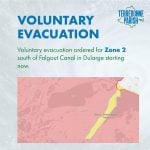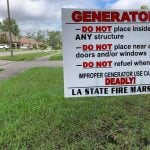
TPCG issues a voluntary evacuation for Zone 2
September 10, 2024
Avoid dangerous accidents by following these generator safety tips
September 10, 2024Natural disasters, like hurricanes, can be overwhelming and frightening for children. Many children who lived through Hurricane Ida, for example, still remember the fear and uncertainty it brought, as well as the disruptions to their daily lives.
The destruction and chaos that follows these events can leave a lasting impact on children. Whether witnessing the devastation firsthand or watching it unfold on television, they often struggle to process their emotions. According to FEMA, it’s essential to encourage them to openly express their feelings. Providing support and understanding during these challenging times can help them build resilience and a sense of security.
FEMA encourages parents and caregiver to look for these signs in children who may need help coping with the aftermath of natural disasters:
- Birth through six years: Infants and very young children may be more irritable, crying more than usual, and need more comfort than before the disaster. Preschool and kindergarten children can feel helpless and frightened about separation from their parents. They may resume thumb sucking or bedwetting.
- Seven through 10 years: Older children may become preoccupied with the disaster and want to talk about it continually. They may fear the disaster will happen again and may have strong angry or sad feelings. Children who act out may be expressing grief and trauma. A child may behave as if he or she has no feelings. This numbness can be an emotional shield that protects the child from experiencing pain.
- Eleven through 18 years: Teenagers may react with risk-taking behaviors, such as reckless driving or alcohol and drug abuse. Teenagers can be overwhelmed by their intense emotions and be unable to talk about them.
Here are some tips to help children recover and cope with their situation:
- Limit TV time: Intense media coverage of disasters can frighten young children and disturb teenagers as well.
- Keep to a routine: Structure can make them feel more at ease or provide a sense of familiarity. When schools and childcare open again, help them to return to normal activities including going back to class, sports and play groups.
- Make time for them: Help kids to understand that they are safe and secure by talking, playing and doing other family activities with them. To help younger children feel safe and calm, read a favorite book or play a relaxing family game.
Useful Links to Resources:
- The Center for Disease Control website has useful resources for children at https://www.cdc.gov/childrenindisasters/index.html
- The CDC has created an activity book to offer parents and educators an interactive way to talk to kids about how to cope after a disaster. It can be used in schools, communities, and families to help children talk about their feelings after a disaster and learn positive ways to express their emotions in uncertain times. https://www.cdc.gov/phpr/readywrigley/documents/RW_Coping_After_a_Disaster_508.pdf
- FEMA has a section of its newly updated website https://www.ready.gov/kids devoted to helping children understand disasters, and prepare for a storm with games and stories, in English and Spanish. FEMA website: www.ready.gov/coping-with-disaster and www.fema.gov/children-and-disasters.
- Save the Children: go to www.savethechildren.org and search “Tips to Help Kids Cope with Disasters”.
- American Academy of Pediatrics: go to www.healthychildren.org and search
- “Helping your Child Cope”
- “Talking to Children about Disasters”
- “How Children of Different Ages Respond to Disasters”
- National Child Traumatic Stress Network: www.nctsn.org




